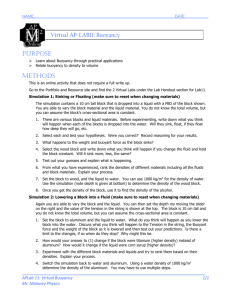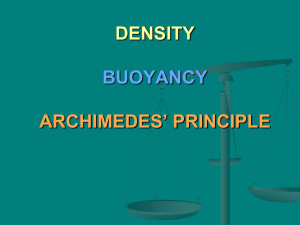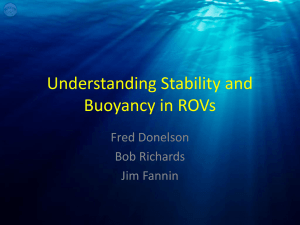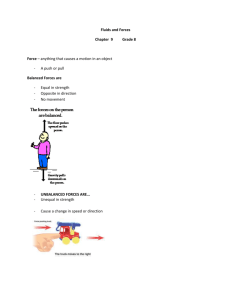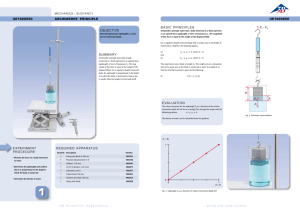Archimedes' Principle - San Diego Mesa College
advertisement
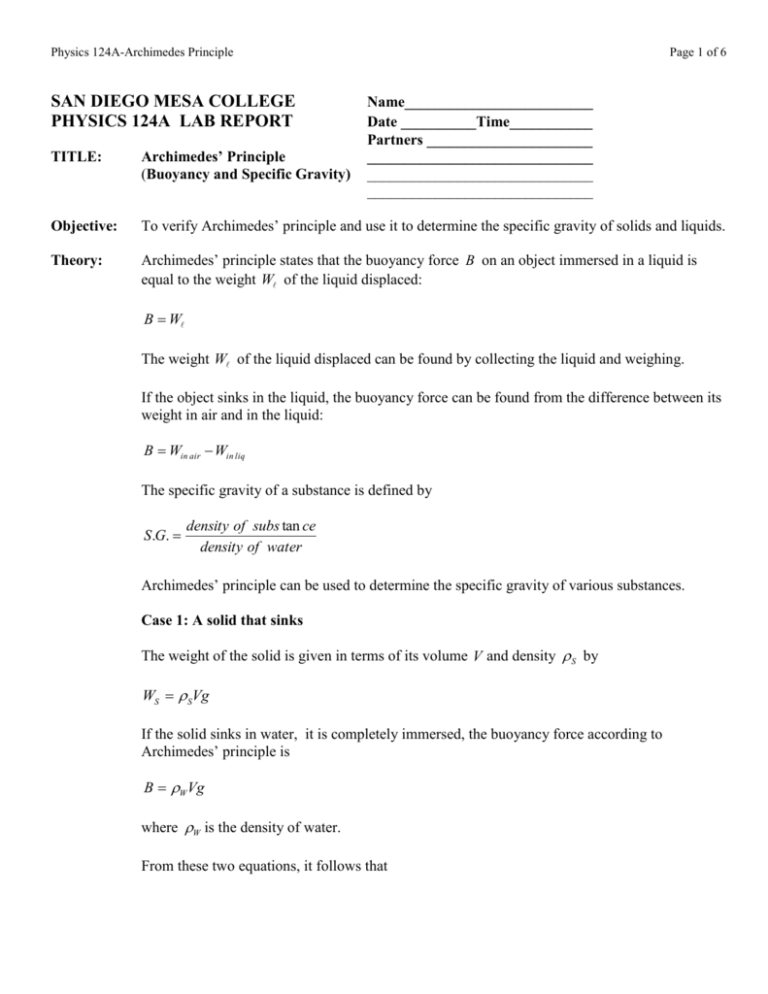
Physics 124A-Archimedes Principle SAN DIEGO MESA COLLEGE PHYSICS 124A LAB REPORT Page 1 of 6 Name_________________________ Date __________Time___________ Partners ______________________ ______________________________ ______________________________ ______________________________ TITLE: Archimedes’ Principle (Buoyancy and Specific Gravity) Objective: To verify Archimedes’ principle and use it to determine the specific gravity of solids and liquids. Theory: Archimedes’ principle states that the buoyancy force B on an object immersed in a liquid is equal to the weight W of the liquid displaced: B W The weight W of the liquid displaced can be found by collecting the liquid and weighing. If the object sinks in the liquid, the buoyancy force can be found from the difference between its weight in air and in the liquid: B Win air Win liq The specific gravity of a substance is defined by S .G. density of subs tan ce density of water Archimedes’ principle can be used to determine the specific gravity of various substances. Case 1: A solid that sinks The weight of the solid is given in terms of its volume V and density S by WS SVg If the solid sinks in water, it is completely immersed, the buoyancy force according to Archimedes’ principle is B WVg where W is the density of water. From these two equations, it follows that Physics 124A-Archimedes Principle S .G. S WS W B Page 2 of 6 (1) which determines the specific gravity in terms of WS and B . Case 2 A floating object A floating object can be made to sink by tying a piece of metal (the sinker) underneath it. The apparent weight of the assembly when completely immersed in water is less than the apparent weight when only the sinker is immersed. The difference is the buoyancy force on the object. This can be used in Eq (1) to find the specific gravity of the object. Case 3 Liquid The buoyancy force on a piece of metal depends on the liquid in which it is immersed, and is given according to Archimedes’ principle by B Vg where is the density of the liquid and V is the volume of the metal. It can be found by weighing the metal in air and in the liquid. If the liquid is water, the buoyancy force is BW WVg From these equations, it follows that the specific gravity of the liquid is S .G. B BW Equipment: Overflow Can Catch Bucket Wood Cylinder Lead cube Aluminum Cylinder Hooked Masses Thin String Double Pan Balance Balance Elevation Mount Scissors 1000mL Ungraduated Cylinder Detergent DeIonized Water Electronic Balance Physics 124A-Archimedes Principle Page 3 of 6 In this experiment, all weights will be recorded in gram weight, or simply gram. PART I: Verification of Archimedes’ principle and specific gravity of sinking solids Setup: Procedure: Use the electronic balance to find the weight of the lead cube in grams. Make sure the balance reads 00.00 before weighing. If it doesn’t then momentarily push the “tare” button, wait a few seconds and it should read zero. Remember weight is a measure of force. Measure the weight of the catch bucket. In this part of the experiment you will be suspending the samples from the hooks underneath the pans of the double pan balance. Do this using a piece of thread that is long enough to get the mass submerged in the bucket and still remain above the table. Hang the lead weight from the bottom of the pan on the left. Hold it out of the way and move the overflow can directly below the hook. Have your lab partner fill the overflow can with deionized water (NOT tap water), add a drop of detergent and all the excess to run out onto a paper towel. Carefully lower the lead cube into the water, completely submerge it and catch what spills out through the spout with the catch bucket. Weigh the catch bucket and the water together. Now suspend the hooked masses from underneath the other pan until the two pans are balanced (they have equal masses hanging from them). The weight of these hooked masses is equal to the weight of the submerged sample. Finish filling in the data table for lead, then repeat the procedure for the aluminum sample. Physics 124A-Archimedes Principle Page 4 of 6 Data and Analysis: Weight of catch bucket Wempty = Lead 1. Weight of sample in air WS Win air 2. Weight of sample in water Win water 3. Weight of catch bucket and water W fill 4. Buoyancy force B Win air Win water 5. Weight of displaced water W W fill Wempty % difference between 4 and 5 Specific gravity WS B PART II: Specific Density of Floating Solids (Do Not use data from PART I) Setup: Aluminum Physics 124A-Archimedes Principle Page 5 of 6 Procedure: In this experiment you will use a cylinder instead of the can to hold water. Half fill a cylinder with deionized water. Weigh the wood sample. Hang the lead or aluminum weight from the bottom of the wood sample. Weigh the assembly with only the metal immersed in water using the double pan balance by following the procedure described in Part I. Weigh the assembly with both wood sample and metal immersed. You might have to add more water to the cylinder. Data and Analysis: Weight of wood sample WS Weight with sinker submerged W1 Weight with sinker and sample submerged W2 Buoyancy force on sample B W1 W2 S.G. of sample WS B PART III: Specific Gravity of Liquids Procedure: The specific gravity of two liquids, ethylene glycol and propanol, will be determined in this part of the experiment. This is achieved by weighing the aluminum sample in the two liquids, one after the other. The liquids will be provided to you contained in plastic cylinders. The weights of the sample in air and in water are also needed for analysis, but they have already been found in Part I. WARNING: ETHYLENE GLYCOL and PROPANOL CAN BE HAZARDOUS TO YOUR HEALTH IF MISHANDLED. Physics 124A-Archimedes Principle Page 6 of 6 Data and Analysis: Weight of aluminum in air Wair = Weight of aluminum in water Wwater = Buoyancy in water BW Wair Wwater Ethylene Glycol Weight of aluminum in liquid W Buoyancy in liquid B Wair W Specific gravity B BW Conclusions and Comments: Propanol

